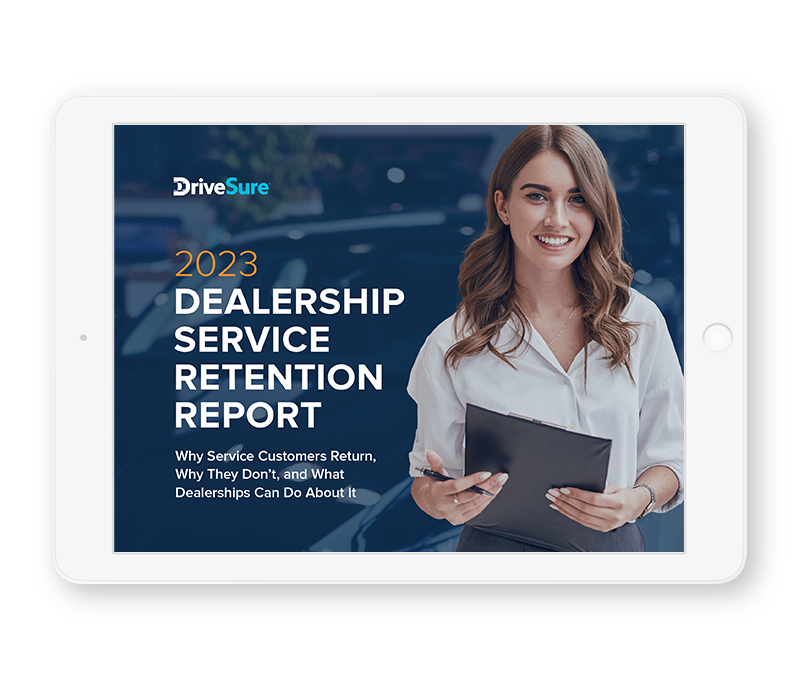A recent study by Cox Automotive reveals a concerning trend for franchised dealerships: a significant loss in service visit share to general repair shops. In 2021, dealerships accounted for 35% of all service visits in the U.S., but by 2023, this figure had declined to 30%.
Dealerships are now facing increased competition from service chains and general repair shops. The implications are concerning as they tie directly to dealership revenue and customer loyalty. So why exactly are dealership customers losing their loyalty, and what should they do to start winning back customers?
Between the Cox report and DriveSure’s own research, let’s take a look at some key insights that dealerships should pay attention to if they want to keep customers coming back.
Why are vehicle owners going elsewhere for service?
Cost concerns
The primary reason vehicle owners are turning away from dealership services is cost related. The Cox Automotive Service Study highlighted that four out of the top five reasons for not returning to a dealership for service are associated with cost, such as services costing higher than the estimate.
This sentiment is echoed in DriveSure’s 2023 Dealership Service Retention Report, which illustrates how a significant barrier to dealership retention is the feeling of being overcharged. In our survey, 40 percent of dealership customers said they might leave for a lower price.
This concern over cost not only influences the initial decision to seek alternatives but also affects long-term customer loyalty and, in some cases, trust.
What keeps customers coming back to your dealership?
Insights from Nearly 1,500 Dealership Customers
Service quality and customer service
Another critical factor is the perceived quality of service and customer experience. According to the Cox report, nearly half (48%) of vehicle owners reported frustration with at least one aspect of their service experience at a dealership.
These frustrations range from the service taking longer than expected to feeling pressured into unnecessary additional services. Such negative experiences erode trust and satisfaction, driving customers to seek alternatives that they perceive as offering better service quality and customer care.
This is especially concerning because the DriveSure report found over half (56%) of vehicle owners said they might leave after a bad experience at their dealership.
Appointment availability
Being overbooked may cost you customers. Both the Cox report and the DriveSure report found the importance of service appointment availability as a determinant of customer preference and satisfaction.
Further supporting this, the DriveSure report reveals that 32% of customers cite “limited availability for service appointments” as a significant reason for choosing not to return to a dealership for service.
Dealerships that struggle to offer timely and convenient appointments risk losing customers to general repair shops that can. This challenge highlights the need for dealerships to enhance their service lane capacity and implement efficient scheduling systems to meet customer expectations for accessibility and convenience.
Be aware of online scheduling challenges
On a related note, many vehicle owners prefer the convenience of digital booking but often encounter limited options, leading to frustration and disconnection. With this lack of advanced booking tools or a human to help solve problems when they arise, dealerships lose appointments and might not even know it. DriveSure’s research has found customers have similar frustrations with automated phone systems.
This situation not only hinders immediate service opportunities but also drives customers to seek alternatives, potentially eroding dealership loyalty. An effective online scheduling system needs to reflect a dealership’s commitment to accommodating customer needs, consistent with overall service quality.
How to improve retention at your dealership
Enhance service lane capacity to keep appointment availability high
Boosting the capacity of your service lane lets you handle more vehicles and make the most out of high-demand periods. By increasing the number of available appointments, customers find it more convenient to access your services, thereby enhancing their likelihood of returning.
Fortunately, improving your service lane’s capacity doesn’t have to mean major investments or expansive renovations. Even minor adjustments can significantly improve what the service lane can handle.
For example, ensuring a higher number of technicians are available during busy periods, optimizing the check-in process for speed and efficiency, and wisely delegating tasks based on each technician’s level of expertise (that is, saving complex tasks for your seasoned technicians and simpler ones for less experienced staff) can all contribute to a smoother, more efficient service operation.
Simplify prepaid maintenance to address cost concerns
By making prepaid maintenance (PPM) plans easy to understand and use, dealerships can both increase repair order revenue and improve customer retention rates. This approach directly combats the perception of being overcharged, providing clear value to the customer.
While these are typically sold in F&I, there is a much stronger case for selling PPMs in the service lane, as we’ve outlined in the past.
According to the DriveSure report, 78% of customers indicated a willingness to purchase a PPM package if it came with the right incentives, such as a 20% discount, highlighting a substantial opportunity for dealerships to drive revenue and encourage repeat visits. A simple offer with a short duration can work wonders for selling PPMs.
Why PPMs help customer retention
- Convenience: With services prepaid, customers enjoy hassle-free visits without the need to discuss payments each time, streamlining their experience.
- Financial incentives: The upfront investment in a PPM creates a tangible commitment to the dealership, encouraging customers to return to maximize their plan’s value.
- Trust building: Regular maintenance checks offer dealerships more opportunities to solidify their relationship with the customer, building trust with consistent, reliable service, and transparent interactions.
- Proactive care: Scheduled visits allow dealerships to identify and address minor issues early, preventing bigger problems and demonstrating their commitment to the customer’s vehicle’s health.
Educate customers on offered services
A significant portion of customer defection stems from a lack of awareness about the dealership’s full range of services, especially in areas like tire sales and maintenance. While not mentioned in the Cox report, a customer’s lack of awareness of their dealership’s tire services often causes them to get the service done elsewhere, risking defection.
Dealerships need to effectively communicate their offerings, not just from staff but in service reminders, or even personalized emails detailing available services and benefits. This not only increases awareness but also positions the dealership as a one-stop solution for all automotive needs.
Provide more value-added services for a remarkable customer experience
Customer interest at dealerships is increasingly focused on value-added services, a trend underscored by the DriveSure report. The most sought-after amenities include:
- Complimentary tire replacements due to wear
- Powertrain warranties for regularly serviced vehicles, and
- Tire replacement for road hazard damage
These preferences signal customers are less enthusiastic about common perks like free wifi. While some of these options are difficult to implement, dealerships can easily set up service to provide tire replacement for road hazard damage, using DriveSure’s Renewable Benefits.
The Renewable Benefits program offers unique benefits like road hazard tire protection and dealer-loyal roadside assistance, directly addressing these evolving consumer preferences. By integrating such services with every service visit, dealerships can significantly enhance customer loyalty and satisfaction, setting themselves apart in a competitive market.
What keeps customers coming back to your dealership?
Download the 2023 Dealership Service Retention Report to see what dealership service customers have to say.


